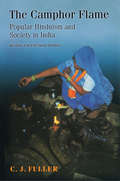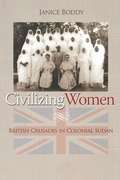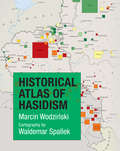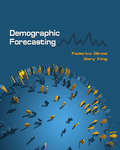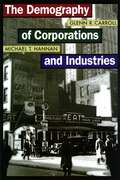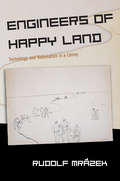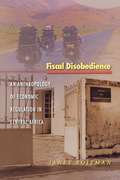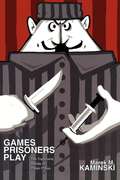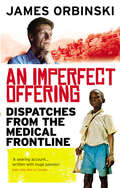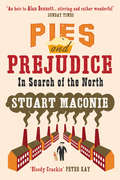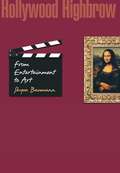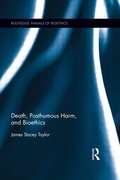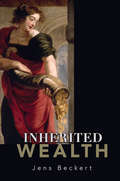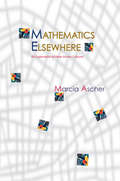- Table View
- List View
The Camphor Flame: Popular Hinduism and Society in India - Revised and Expanded Edition (PDF)
by C. J. FullerPopular Hinduism is shaped, above all, by worship of a multitude of powerful divine beings--a superabundance indicated by the proverbial total of 330 million gods and goddesses. The fluid relationship between these beings and humans is a central theme of this rich and accessible study of popular Hinduism in the context of the society of contemporary India. Lucidly organized and skillfully written, The Camphor Flame brings clarity to an immensely complicated subject. C. J. Fuller combines ethnographic case studies with comparative anthropological analysis and draws on textual and historical scholarship as well. The book's new afterword brings the study up-to-date by examining the relationship between popular Hinduism and contemporary Hindu nationalism.
Civilizing Women: British Crusades in Colonial Sudan (PDF)
by Janice BoddyCivilizing Women is a riveting exploration of the disparate worlds of British colonial officers and the Muslim Sudanese they sought to remake into modern imperial subjects. Focusing on efforts to stop female circumcision in the Anglo-Egyptian Sudan between 1920 and 1946, Janice Boddy mines colonial documents and popular culture for ethnographic details to interleave with observations from northern Sudan, where women's participation in zâr spirit possession rituals provided an oblique counterpoint to colonial views. Written in engaging prose, Civilizing Women concerns the subtle process of "colonizing selfhood," the British women who undertook it, and those they hoped to reform. It suggests that efforts to suppress female circumcision were tied to the continuation of slavery and the rise of commercial cotton growing in Sudan, as well as to concerns about infant mortality and maternal health. Boddy traces maneuverings among political officers, teachers, missionaries, and medical personnel as they pursued their elusive goal, and describes their fraught relations with Egypt, Parliament, the Foreign Office, African nationalists, and Western feminists. In doing so, she sounds a cautionary note for contemporary interventionists who would flout local knowledge and belief.
Historical Atlas of Hasidism
by Marcin WodzińskiThe first cartographic reference book on one of today’s most important religious movementsHistorical Atlas of Hasidism is the very first cartographic reference book on one of the modern era's most vibrant and important mystical movements. Featuring sixty-one large-format maps and a wealth of illustrations, charts, and tables, this one-of-a-kind atlas charts Hasidism's emergence and expansion; its dynasties, courts, and prayer houses; its spread to the New World; the crisis of the two world wars and the Holocaust; and Hasidism's remarkable postwar rebirth.Historical Atlas of Hasidism demonstrates how geography has influenced not only the social organization of Hasidism but also its spiritual life, types of religious leadership, and cultural articulation. It focuses not only on Hasidic leaders but also on their thousands of followers living far from Hasidic centers. It examines Hasidism in its historical entirety, from its beginnings in the eighteenth century until today, and draws on extensive GIS-processed databases of historical and contemporary records to present the most complete picture yet of this thriving and diverse religious movement.Historical Atlas of Hasidism is visually stunning and easy to use, a magnificent resource for anyone seeking to understand Hasidism's spatial and spiritual dimensions, or indeed anybody interested in geographies of religious movements past and present.Provides the first cartographic interpretation of HasidismFeatures sixty-one maps and numerous illustrationsCovers Hasidism in its historical entirety, from its eighteenth-century origins to todayCharts Hasidism's emergence and expansion, courts and prayer houses, modern resurgence, and much moreOffers the first in-depth analysis of Hasidism's egalitarian--not elitist—dimensionsDraws on extensive GIS-processed databases of historical and contemporary records
Demographic Forecasting (PDF)
by Federico Girosi Gary KingDemographic Forecasting introduces new statistical tools that can greatly improve forecasts of population death rates. Mortality forecasting is used in a wide variety of academic fields, and for policymaking in global health, social security and retirement planning, and other areas. Federico Girosi and Gary King provide an innovative framework for forecasting age-sex-country-cause-specific variables that makes it possible to incorporate more information than standard approaches. These new methods more generally make it possible to include different explanatory variables in a time-series regression for each cross section while still borrowing strength from one regression to improve the estimation of all. The authors show that many existing Bayesian models with explanatory variables use prior densities that incorrectly formalize prior knowledge, and they show how to avoid these problems. They also explain how to incorporate a great deal of demographic knowledge into models with many fewer adjustable parameters than classic Bayesian approaches, and develop models with Bayesian priors in the presence of partial prior ignorance. By showing how to include more information in statistical models, Demographic Forecasting carries broad statistical implications for social scientists, statisticians, demographers, public-health experts, policymakers, and industry analysts. Introduces methods to improve forecasts of mortality rates and similar variables Provides innovative tools for more effective statistical modeling Makes available free open-source software and replication data Includes full-color graphics, a complete glossary of symbols, a self-contained math refresher, and more
The Demography of Corporations and Industries (PDF)
by Glenn R. Carroll Michael T. HannanMost analysts of corporations and industries adopt the focal perspective of a single prototypical organization. Many analysts also study corporations primarily in terms of their internal organizational structures or as complex systems of financial contracts. Glenn Carroll and Michael Hannan bring fresh insight to our understanding of corporations and the industries they comprise by looking beyond prototypical structures to focus on the range and diversity of organizations in their social and economic setting. The result is a rich rendering of analysis that portrays whole populations and communities of corporations. The Demography of Corporations and Industries is the first book to present the demographic approach to organizational studies in its entirety. It examines the theory, models, methods, and data used in corporate demographic research. Carroll and Hannan explore the processes by which corporate populations change over time, including organizational founding, growth, decline, structural transformation, and mortality. They review and synthesize the major theoretical mechanisms of corporate demography, ranging from aging and size dependence to population segregation and density dependence. The book also explores some selected implications of corporate demography for public policy, including employment and regulation. In this path-breaking book, Carroll and Hannan demonstrate why demographic research on corporations is important; describe how to conduct demographic research; specify fruitful areas of future research; and suggest how the demographic perspective can enrich the public discussion of issues surrounding the corporation in our constantly evolving industrial society. All researchers and analysts with an interest in this topic will find The Demography of Corporations and Industries an invaluable resource.
The Devil in Silicon Valley: Northern California, Race, and Mexican Americans
by Stephen J. PittiThis sweeping history explores the growing Latino presence in the United States over the past two hundred years. It also debunks common myths about Silicon Valley, one of the world's most influential but least-understood places. Far more than any label of the moment, the devil of racism has long been Silicon Valley's defining force, and Stephen Pitti argues that ethnic Mexicans--rather than computer programmers--should take center stage in any contemporary discussion of the "new West." Pitti weaves together the experiences of disparate residents--early Spanish-Mexican settlers, Gold Rush miners, farmworkers transplanted from Texas, Chicano movement activists, and late-twentieth-century musicians--to offer a broad reevaluation of the American West. Based on dozens of oral histories as well as unprecedented archival research, The Devil in Silicon Valley shows how San José, Santa Clara, and other northern California locales played a critical role in the ongoing development of Latino politics. This is a transnational history. In addition to considering the past efforts of immigrant and U.S.-born miners, fruit cannery workers, and janitors at high-tech firms--many of whom retained strong ties to Mexico--Pitti describes the work of such well-known Valley residents as César Chavez. He also chronicles the violent opposition ethnic Mexicans have faced in Santa Clara Valley. In the process, he reinterprets not only California history but the Latino political tradition and the story of American labor. This book follows California race relations from the Franciscan missions to the Gold Rush, from the New Almaden mine standoff to the Apple janitorial strike. As the first sustained account of Northern California's Mexican American history, it challenges conventional thinking and tells a fascinating story. Bringing the past to bear on the present, The Devil in Silicon Valley is counter-history at its best.
NGOs and Accountability in China: Child Welfare Organisations
by Jude Howell Xiaoyuan Shang Karen R. FisherThis book investigates how NGOs in authoritarian states, such as China, craft accountability and legitimacy to ensure their survival. It explores this through the lens of child welfare organisations from 2007 to 2017. The authors provide a fresh approach to accountability that is more attuned to the particular conditions of authoritarianism. The project explores the effects of power relations in shaping the hierarchies of accountability and participation that emerge and the attention given to different voices such as those of donor, government, and users. Essential reading for researchers and policy makers interested in development, NGO, social policy, political science, and child welfare studies.
NGOs and Accountability in China: Child Welfare Organisations
by Jude Howell Xiaoyuan Shang Karen R. FisherThis book investigates how NGOs in authoritarian states, such as China, craft accountability and legitimacy to ensure their survival. It explores this through the lens of child welfare organisations from 2007 to 2017. The authors provide a fresh approach to accountability that is more attuned to the particular conditions of authoritarianism. The project explores the effects of power relations in shaping the hierarchies of accountability and participation that emerge and the attention given to different voices such as those of donor, government, and users. Essential reading for researchers and policy makers interested in development, NGO, social policy, political science, and child welfare studies.
Engineers of Happy Land: Technology and Nationalism in a Colony (PDF) (Princeton Studies in Culture/Power/History)
by Rudolf MrázekBased on close reading of historical documents--poetry as much as statistics--and focused on the conceptualization of technology, this book is an unconventional evocation of late colonial Netherlands East Indies (today Indonesia). In considering technology and the ways that people use and think about things, Rudolf Mrázek invents an original way to talk about freedom, colonialism, nationalism, literature, revolution, and human nature. The central chapters comprise vignettes and take up, in turn, transportation (from shoes to road-building to motorcycle clubs), architecture (from prison construction to home air-conditioning), optical technologies (from photography to fingerprinting), clothing and fashion, and the introduction of radio and radio stations. The text clusters around a group of fascinating recurring characters representing colonialism, nationalism, and the awkward, inevitable presence of the European cultural, intellectual, and political avant-garde: Tillema, the pharmacist-author of Kromoblanda; the explorer/engineer IJzerman; the "Javanese princess" Kartina; the Indonesia nationalist journalist Mas Marco; the Dutch novelist Couperus; the Indonesian novelist Pramoedya Ananta Toer; and Dutch left-wing liberal Wim Wertheim and his wife. In colonial Indies, as elsewhere, people employed what Proust called "remembering" and what Heidegger called "thinging" to sense and make sense of the world. In using this observation to approach Indonesian society, Mrázek captures that society off balance, allowing us to see it in unfamiliar positions. The result is a singular work with surprises for readers throughout the social sciences, not least those interested in Southeast Asia or colonialism more broadly.
Fiscal Disobedience: An Anthropology of Economic Regulation in Central Africa (In-Formation (PDF))
by Janet RoitmanFiscal Disobedience represents a novel approach to the question of citizenship amid the changing global economy and the fiscal crisis of the nation-state. Focusing on economic practices in the Chad Basin of Africa, Janet Roitman combines thorough ethnographic fieldwork with sophisticated analysis of key ideas of political economy to examine the contentious nature of fiscal relationships between the state and its citizens. She argues that citizenship is being redefined through a renegotiation of the rights and obligations inherent in such economic relationships. The book centers on a civil disobedience movement that arose in Cameroon beginning in 1990 ostensibly to counter state fiscal authority--a movement dubbed Opération Villes Mortes by the opposition and incivisme fiscal by the government (which for its part was eager to suggest that participants were less than legitimate citizens, failing in their civic duties). Contrary to standard approaches, Roitman examines this conflict as a "productive moment" that, rather than involving the outright rejection of regulatory authority, questioned the intelligibility of its exercise. Although both militarized commercial networks (associated with such activities trading in contraband goods including drugs, ivory, and guns) and highly organized gang-based banditry do challenge state authority, they do not necessarily undermine state power. Contrary to depictions of the African state as "weak" or "failed," this book demonstrates how the state in Africa manages to reconstitute its authority through networks that have emerged in the interstices of the state system. It also shows how those networks partake of the same epistemological grounding as does the state. Indeed, both state and nonstate practices of governing refer to a common "ethic of illegality," which explains how illegal activities are understood as licit or reasonable conduct.
Games Prisoners Play: The Tragicomic Worlds of Polish Prison (PDF)
by Marek M. KaminskiOn March 11, 1985, a van was pulled over in Warsaw for a routine traffic check that turned out to be anything but routine. Inside was Marek Kaminski, a Warsaw University student who also ran an underground press for Solidarity. The police discovered illegal books in the vehicle, and in a matter of hours five secret police escorted Kaminski to jail. A sociology and mathematics major one day, Kaminski was the next a political prisoner trying to adjust to a bizarre and dangerous new world. This remarkable book represents his attempts to understand that world. As a coping strategy until he won his freedom half a year later by faking serious illness, Kaminski took clandestine notes on prison subculture. Much later, he discovered the key to unlocking that culture--game theory. Prison first appeared an irrational world of unpredictable violence and arbitrary codes of conduct. But as Kaminski shows in riveting detail, prisoners, to survive and prosper, have to master strategic decision-making. A clever move can shorten a sentence; a bad decision can lead to rape, beating, or social isolation. Much of the confusion in interpreting prison behavior, he argues, arises from a failure to understand that inmates are driven not by pathological emotion but by predictable and rational calculations. Kaminski presents unsparing accounts of initiation rituals, secret codes, caste structures, prison sex, self-injuries, and of the humor that makes this brutal world more bearable. This is a work of unusual power, originality, and eloquence, with implications for understanding human behavior far beyond the walls of one Polish prison.
The Ice Museum: In Search Of The Lost Land Of Thule
by Joanna KavennaJoanna Kavenna went north in search of the Atlantis of the Arctic, the mythical land of Thule. Seen once by an Ancient Greek explorer and never found again, mysterious Thule came to represent the vast and empty spaces of the north. Fascinated for many years by Arctic places, Kavenna decided to travel through the lands that have been called Thule, from Shetland to Iceland, Norway, Estonia, and Greenland. On her journey, she found traces of earlier writers and travellers, all compelled by the idea of a land called Thule: Richard Francis Burton, William Morris, Anthony Trollope, as well as the Norwegian Polar explorer Fridtjof Nansen. She met wilderness-lovers; poets writing epics about ice; Inuit musicians and Polar scientists trying to understand the silent snows. But she came to discover that a darkness also inhabits Thule: the Thule Society, obsessed with the purity of the Nordic peoples; the 'war children' - the surviving progeny of Nazi attempts to foster an Aryan race; as well as ice-bound relics of the Cold War. Finally she arrived in Svalbard, a beautiful Arctic archipelago, at the edge of the frozen ocean. Blending travelogue, reportage, memoir, and literary essay, Joanna Kavenna explores the changing life of the far North in the 20th Century. The Ice Museum is a mesmerising story of idealism and ambition, wars and destruction, survival and memories, set against the haunting backdrop of the northern landscape.
An Imperfect Offering: Dispatches From The Medical Frontline
by James OrbinskiBorn in Britain in 1960, James Orbinski's family moved to Canada when he was seven years old. As a young man, he became a medic to learn how to help, and deal with, the suffering of others. From then on he was plunged into many highly demanding situations, including being Head of Mission for Medecins Sans Frontieres (MSF) during the Rwandan genocide; engaging with the politics of humanitarian work as the President of MSF; being in New York when the twin towers of the World Trade Center fell on September 11; co-founding Dignitas International (an AIDS charity); and finally, returning to Rwanda on the 10th anniversary of the crisis there. In An Imperfect Offering, Orbinski not only tells his own inspiring story but is also remarkably provocative about what governments and agencies should and shouldn't be doing to help the world's poor and very sick. At the same time, he addresses what part each of us can play, so that we never lose sight of the dignity of those being helped, or deny them the right to act in their own lives. His conclusion is blunt and profound: 'Humanity is lost or saved one person at a time, one intention at a time, and one action at a time. There are no utopias waiting to be born. There is only what we do - what you choose to do...'
Pies and Prejudice: In Search Of The North
by Stuart MaconieA Northerner in exile, Stuart Maconie goes on a journey in search of the North, attempting to discover where the clichés end and the truth begins. He travels from Wigan Pier to Blackpool Tower and Newcastle's Bigg Market to the Lake District to find his own Northern Soul, encountering along the way an exotic cast of chippy Scousers, pie-eating woollybacks, topless Geordies, mad-for-it Mancs, Yorkshire nationalists and brothers in southern exile. The bestselling Pies and Prejudice is a hugely enjoyable journey around the north of England.
History in Exile: Memory and Identity at the Borders of the Balkans
by Pamela BallingerIn the decade after World War II, up to 350,000 ethnic Italians were displaced from the border zone between Italy and Yugoslavia known as the Julian March. History in Exile reveals the subtle yet fascinating contemporary repercussions of this often overlooked yet contentious episode of European history. Pamela Ballinger asks: What happens to historical memory and cultural identity when state borders undergo radical transformation? She explores displacement from both the viewpoints of the exiles and those who stayed behind. Yugoslavia's breakup and Italy's political transformation in the early 1990s, she writes, allowed these people to bring their histories to the public eye after nearly half a century. Examining the political and cultural contexts in which this understanding of historical consciousness has been formed, Ballinger undertakes the most extensive fieldwork ever done on this subject--not only around Trieste, where most of the exiles settled, but on the Istrian Peninsula (Croatia and Slovenia), where those who stayed behind still live. Complementing this with meticulous archival research, she examines two sharply contrasting models of historical identity yielded by the "Istrian exodus": those who left typically envision Istria as a "pure" Italian land stolen by the Slavs, whereas those who remained view it as ethnically and linguistically "hybrid." We learn, for example, how members of the same family, living a short distance apart and speaking the same language, came to develop a radically different understanding of their group identities. Setting her analysis in engaging, jargon-free prose, Ballinger concludes that these ostensibly very different identities in fact share a startling degree of conceptual logic.
Hollywood Highbrow: From Entertainment to Art (PDF) (Princeton Studies in Cultural Sociology #30)
by Shyon BaumannToday's moviegoers and critics generally consider some Hollywood products--even some blockbusters--to be legitimate works of art. But during the first half century of motion pictures very few Americans would have thought to call an American movie "art." Up through the 1950s, American movies were regarded as a form of popular, even lower-class, entertainment. By the 1960s and 1970s, however, viewers were regularly judging Hollywood films by artistic criteria previously applied only to high art forms. In Hollywood Highbrow, Shyon Baumann for the first time tells how social and cultural forces radically changed the public's perceptions of American movies just as those forces were radically changing the movies themselves. The development in the United States of an appreciation of film as an art was, Baumann shows, the product of large changes in Hollywood and American society as a whole. With the postwar rise of television, American movie audiences shrank dramatically and Hollywood responded by appealing to richer and more educated viewers. Around the same time, European ideas about the director as artist, an easing of censorship, and the development of art-house cinemas, film festivals, and the academic field of film studies encouraged the idea that some American movies--and not just European ones--deserved to be considered art.
Identity and Religion in Palestine: The Struggle between Islamism and Secularism in the Occupied Territories (PDF) (Princeton Studies in Muslim Politics #21)
by Loren D. LybargerThis remarkable book examines how the Islamist movement and its competition with secular-nationalist factions have transformed the identities of ordinary Palestinians since the first Palestinian uprising, or intifada, of the late 1980s. Drawing upon his years living in the region and more than eighty in-depth interviews, Loren Lybarger offers a riveting account of how activists within a society divided by religion, politics, class, age, and region have forged new identities in response to shifting conditions of occupation, peace negotiations, and the fragmentation of Palestinian life. Lybarger personally witnessed the tragic days of the first intifada, the subsequent Oslo Peace Process and its failures, and the new escalation of violence with the second intifada in 2000. He rejects the simplistic notion that Palestinians inevitably fall into one of two camps: pragmatists who are willing to accept territorial compromise, and extremists who reject compromise in favor of armed struggle. Listening carefully to Palestinians themselves, he reveals that the conflicts evident among the Islamists and secular nationalists are mirrored by the internal struggles and divided loyalties of individual Palestinians. Identity and Religion in Palestine is the first book of its kind in English to capture so faithfully the rich diversity of voices from this troubled part of the world. Lybarger provides vital insights into the complex social dynamics through which Islamism has reshaped what it means to be Palestinian.
Death, Posthumous Harm, And Bioethics
by James Stacey TaylorDeath, Posthumous Harm, and Bioethics offers a highly distinctive and original approach to the metaphysics of death and applies this approach to contemporary debates in bioethics that address end-of-life and post-mortem issues. Taylor defends the controversial Epicurean view that death is not a harm to the person who dies and the neo-Epicurean thesis that persons cannot be affected by events that occur after their deaths, and hence that posthumous harms (and benefits) are impossible. He then extends this argument by asserting that the dead cannot be wronged, finally presenting a defence of revisionary views concerning posthumous organ procurement.
Death, Posthumous Harm, And Bioethics (PDF)
by James Stacey TaylorDeath, Posthumous Harm, and Bioethics offers a highly distinctive and original approach to the metaphysics of death and applies this approach to contemporary debates in bioethics that address end-of-life and post-mortem issues. Taylor defends the controversial Epicurean view that death is not a harm to the person who dies and the neo-Epicurean thesis that persons cannot be affected by events that occur after their deaths, and hence that posthumous harms (and benefits) are impossible. He then extends this argument by asserting that the dead cannot be wronged, finally presenting a defence of revisionary views concerning posthumous organ procurement.
Inherited Wealth (PDF)
by Jens Beckert Thomas DunlapHow to regulate the transfer of wealth from one generation to the next has been hotly debated among politicians, legal scholars, sociologists, economists, and philosophers for centuries. Bequeathing wealth is a vital ingredient of family solidarity. But does the reproduction of social inequality through inheritance square with the principle of equal opportunity? Does democracy suffer when family wealth becomes political power? The first in-depth, comparative study of the development of inheritance law in the United States, France, and Germany, Inherited Wealth investigates longstanding political and intellectual debates over inheritance laws and explains why these laws still differ so greatly among these countries. Using a sociological perspective, Jens Beckert sheds light on the four most controversial issues in inheritance law during the past two centuries: the freedom to dispose of one's property as one wishes, the rights of family members to the wealth bequeathed, the dissolution of entails (which restrict inheritance to specific classes of heirs), and estate taxation. Beckert shows that while the United States, France, and Germany have all long defended inheritance rights based on the notion of individual property rights, they have justified limitations on inheritance rights in profoundly different ways, reflecting culturally specific ways of understanding the problems of inherited wealth.
The Golden Bough: A Study In Comparative Religion, Volume 2... (Penguin Modern Classics)
by James Frazer George StockingSir James George Frazer (1854-1941) caught the popular imagination with his vast and enterprising comparative study of the beliefs and institutions of mankind, which in its third edition numbered 12 volumes. Reissued here is Frazer's own single-volume abridgement of 1922.
Islamic Modern: Religious Courts and Cultural Politics in Malaysia (PDF) (Princeton Studies in Muslim Politics #11)
by Michael G. PeletzHow do Islamic courts work? What sorts of cultural understandings inform judicial process and litigants' strategies? How do women's claims fare? Do these courts promote social tolerance? And how do states use them to consolidate power, build nations, and shape a modern citizenry? These are among the questions addressed in this book, which not only enhances our understanding of diversity among and within the world's Muslim communities, but also provides ethnographic, historical, and transnational perspectives on contemporary Islam in the shifting landscape of a strategically important region of the world. Focusing on Malaysia, which has sustained more rapid development than probably any other Muslim nation, Michael Peletz explores the culture, political economy, and history of Islamic courts. He demonstrates that they are centrally involved in the creation and policing of new Malay-Muslim identities (such as middle-class urban dwellers) that the state sees as the basis for a national polity that will be highly competitive. He also shows how and why Islamic courts are key sites in struggles involving ethnic and religious groups, social classes, political parties, and others with a major stake in defining Islam's role with respect to the maintenance of sovereignty and the achievement of modernity and civil society in an age of globalization. Peletz deepens our knowledge of Islamic political development in a country very much concerned with forging an Islamic modernity viewed by its leaders as a viable alternative to Western-style modernization.
The King and the Corpse: Tales of the Soul's Conquest of Evil (PDF) (Works by Heinrich Zimmer)
by Joseph Campbell Heinrich Robert ZimmerDrawing from Eastern and Western literatures, Heinrich Zimmer presents a selection of stories linked together by their common concern for the problem of our eternal conflict with the forces of evil. Beginning with a tale from the Arabian Nights, this theme unfolds in legends from Irish paganism, medieval Christianity, the Arthurian cycle, and early Hinduism. In the retelling of these tales, Zimmer discloses the meanings within their seemingly unrelated symbols and suggests the philosophical wholeness of this assortment of myth.
Making Men: Sophists and Self-Presentation in Ancient Rome (PDF)
by Maud W. GleasonThe careers of two popular second-century rhetorical virtuosos offer Maud Gleason fascinating insights into the ways ancient Romans constructed masculinity during a time marked by anxiety over manly deportment. Declamation was an exhilarating art form for the Greeks and bilingual Romans of the Second Sophistic movement, and its best practitioners would travel the empire performing in front of enraptured audiences. The mastery of rhetoric marked the transition to manhood for all aristocratic citizens and remained crucial to a man's social standing. In treating rhetoric as a process of self-presentation in a face-to-face society, Gleason analyzes the deportment and writings of the two Sophists--Favorinus, a eunuch, and Polemo, a man who met conventional gender expectations--to suggest the ways character and gender were perceived. Physiognomical texts of the era show how intently men scrutinized one another for minute signs of gender deviance in such features as gait, gesture, facial expression, and voice. Rhetoricians trained to develop these traits in a "masculine" fashion. Examining the successful career of Favorinus, whose high-pitched voice and florid presentation contrasted sharply with the traditionalist style of Polemo, Gleason shows, however, that ideal masculine behavior was not a monolithic abstraction. In a highly accessible study treating the semiotics of deportment and the medical, cultural, and moral issues surrounding rhetorical activity, she explores the possibilities of self-presentation in the search for recognition as a speaker and a man.
Mathematics Elsewhere: An Exploration of Ideas Across Cultures (PDF)
by Marcia AscherMathematics Elsewhere is a fascinating and important contribution to a global view of mathematics. Presenting mathematical ideas of peoples from a variety of small-scale and traditional cultures, it humanizes our view of mathematics and expands our conception of what is mathematical. Through engaging examples of how particular societies structure time, reach decisions about the future, make models and maps, systematize relationships, and create intriguing figures, Marcia Ascher demonstrates that traditional cultures have mathematical ideas that are far more substantial and sophisticated than is generally acknowledged. Malagasy divination rituals, for example, rely on complex algebraic algorithms. And some cultures use calendars far more abstract and elegant than our own. Ascher also shows that certain concepts assumed to be universal--that time is a single progression, for instance, or that equality is a static relationship--are not. The Basque notion of equivalence, for example, is a dynamic and temporal one not adequately captured by the familiar equal sign. Other ideas taken to be the exclusive province of professionally trained Western mathematicians are, in fact, shared by people in many societies. The ideas discussed come from geographically varied cultures, including the Borana and Malagasy of Africa, the Tongans and Marshall Islanders of Oceania, the Tamil of South India, the Basques of Western Europe, and the Balinese and Kodi of Indonesia. This book belongs on the shelves of mathematicians, math students, and math educators, and in the hands of anyone interested in traditional societies or how people think. Illustrating how mathematical ideas play a vital role in diverse human endeavors from navigation to social interaction to religion, it offers--through the vehicle of mathematics--unique cultural encounters to any reader.
